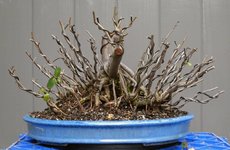Ah, the pleasures of a large Japanese quince. You haven't really enjoyed life until you have a large one in landscape, and it gets a thorny invasive vine tangled up in the interior that you are trying to remove

Japanese quince are most commonly styled as "clump style" bonsai because of their natural growth habit. However clump style doesn't mean "chaos style". You are going to have to wade into all of those trunks and coax some design out of the madness. Along the way you will probably lose 3/4 of those trunks (or more) - but you will be left with a path forward with a handful of trunks instead of 100.
Here is an image from
Nichigo Bonsai in Australia illustrating where I think you need to be headed...

As long as I knew the plant was established in your pot (and healthy) I would start in the spring and shear the entire bush down to about 6"-8" (so that you can see the structure). Prioritize the main trunk (if any) and the largest secondary trunks. You want to end up with a mostly open front (where you can see a trunk line) and then distributed trunks on the left, right, and rear. The trunks don't have to be symmetrical, but they should be balanced visually - i.e. you can go heavier on the side with larger trunks, but make sure you give that side a little more length than the weaker side. Then WIRE ALL THE TRUNKS. Unless you have a contorted quince (you don't) you need to wire in a little character into EVERY TRUNK or they will be arrow straight and boring. And if you don't wire them all, any that you don't wire will stick out visually. Then enjoy your tree. Keep trimming away any new trunks, and wire any new growth before it hardens, and your bonsai will develop quickly. Note - as a general rule if you want blooms you will want to do your heavy pruning in the spring immediately AFTER it flowers. If you wait too long and prune in the late summer, you will likely prune away your flowers for next year. Developing ramification and balancing strength is the key to developing a good Japanese quince clump.